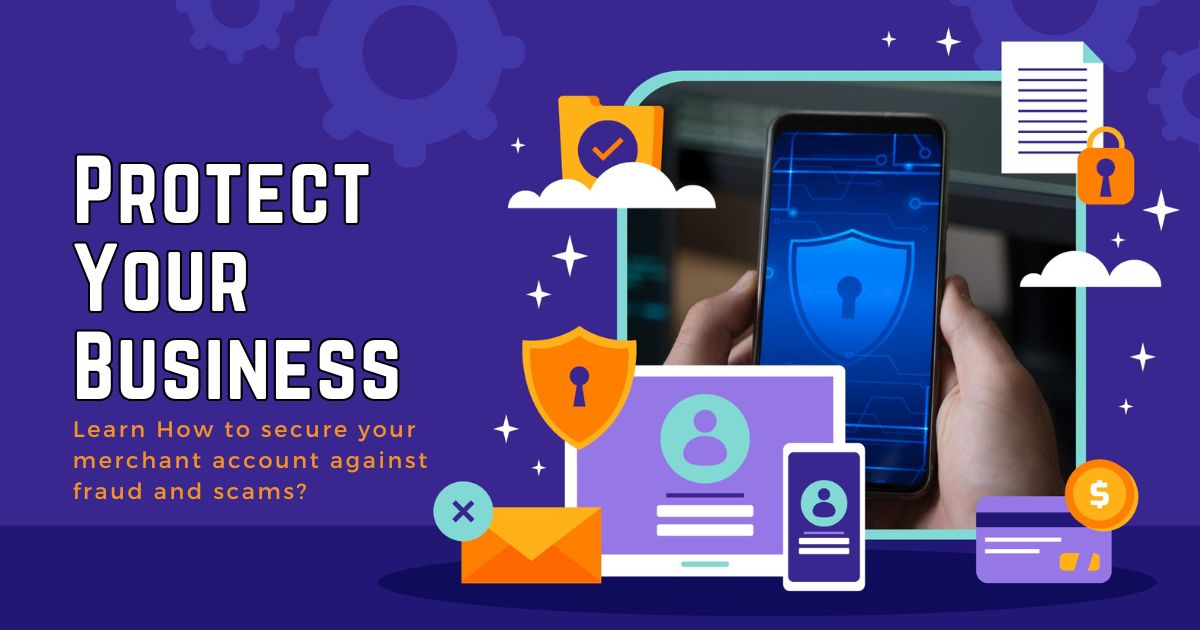
| March 8th, 2024 |
Protect Your Business — Learn How to secure your merchant account against fraud and scams?
In today’s digital age, where businesses rely heavily on online transactions, the risk of merchant account fraud and scams looms large. As technology advances, so do the tactics of fraudsters, making it imperative for businesses to stay vigilant and proactive in safeguarding their financial assets. In this comprehensive guide, we’ll delve into the world of merchant account fraud and scams, exploring the common types, warning signs, prevention strategies, and steps businesses can take to mitigate risks effectively.
Understanding Merchant Account Fraud and Scams —
Merchant account fraud refers to any unauthorized or illegal activity conducted using a business’s payment processing system. Fraudsters exploit vulnerabilities in the payment ecosystem to steal sensitive information, manipulate transactions, or make unauthorized purchases. Some common types of merchant account fraud and scams include:
- Chargeback Fraud: This occurs when a fraudster makes a purchase using a stolen credit card and then disputes the charge, leading to a chargeback for the merchant.
- Identity Theft: Fraudsters obtain personal information from individuals and use it to open merchant accounts or make purchases without their consent.
- Friendly Fraud: In this type of fraud, customers make legitimate purchases but later claim they didn’t authorize the transaction, leading to chargebacks for the merchant.
- Phishing and Spoofing: Fraudsters send deceptive emails or create fake websites to trick individuals into revealing sensitive information like login credentials or credit card details.
Warning Signs of Merchant Account Fraud —
Recognizing the warning signs of merchant account fraud is crucial for businesses to detect and prevent fraudulent activities early. Some common red flags include:
- Unusual or large transactions with unfamiliar customers
- Multiple failed payment attempts from the same customer
- Sudden spikes in chargeback rates or refund requests
- Orders with expedited shipping and no regard for cost
- Inconsistent or mismatched billing and shipping information
Prevention Strategies for Businesses —
Preventing merchant account fraud requires a multi-layered approach that combines robust security measures, employee training, and proactive monitoring. Here are some effective strategies for businesses to safeguard their merchant accounts:
- Implement Secure Payment Systems: Invest in reliable payment processing systems with advanced security features like encryption, tokenization, and fraud detection algorithms.
- Enforce Strong Authentication: Require customers to use multi-factor authentication methods such as SMS verification or biometric authentication for added security.
- Stay Updated with Security Patches: Regularly update your payment systems and software to patch known vulnerabilities and protect against emerging threats.
- Educate Employees and Customers: Train your staff to recognize potential fraud indicators and follow established protocols for verifying transactions. Educate customers about phishing scams and encourage them to use secure payment methods.
- Monitor Transactions Closely: Implement real-time monitoring tools to track transactions for suspicious activities and unusual patterns.
- Set Transaction Limits: Establish transaction limits based on customer profiles and transaction history to minimize the impact of fraudulent activities.
Steps to Take If Fraud Occurs —
Despite your best efforts, your business may still fall victim to merchant account fraud. In such cases, it’s essential to act swiftly to mitigate the damage and prevent future occurrences. Follow these steps if you encounter fraudulent activities:
- Document Everything: Keep detailed records of fraudulent transactions, including timestamps, IP addresses, and any communication with the customer.
- Report to Authorities: Notify law enforcement agencies and relevant authorities about the fraudulent activities, providing them with all available evidence.
- Inform Payment Providers: Contact your payment processor or bank immediately to report the fraud and initiate the chargeback process if necessary.
- Review Security Measures: Conduct a thorough review of your security protocols and systems to identify weaknesses and implement necessary improvements.
- Communicate with Customers: Keep your customers informed about the situation and reassure them of your commitment to resolving any issues and safeguarding their data.
Conclusion —
Merchant account fraud and scams pose a significant threat to businesses of all sizes, but with the right knowledge and strategies, you can protect your business and customers from falling victim to fraudulent activities. By understanding the various types of fraud, recognizing warning signs, implementing preventive measures, and knowing how to respond effectively, you can minimize the risk and maintain the trust and integrity of your business operations in the ever-evolving digital landscape. Stay vigilant, stay proactive, and safeguard your business against merchant account fraud and scams.
